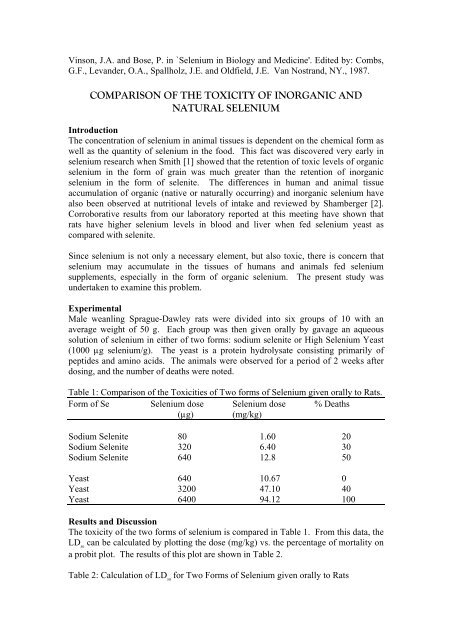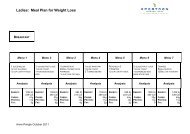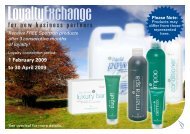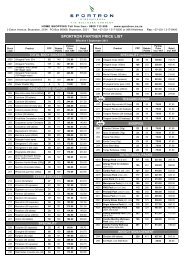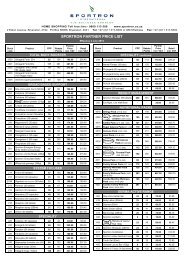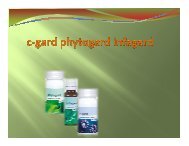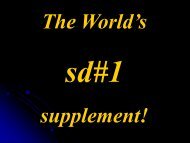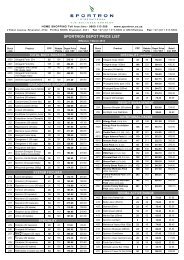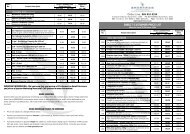Comparison of the Toxicity of Inorganic and Natural Selenium
Comparison of the Toxicity of Inorganic and Natural Selenium
Comparison of the Toxicity of Inorganic and Natural Selenium
You also want an ePaper? Increase the reach of your titles
YUMPU automatically turns print PDFs into web optimized ePapers that Google loves.
Vinson, J.A. <strong>and</strong> Bose, P. in `<strong>Selenium</strong> in Biology <strong>and</strong> Medicine'. Edited by: Combs,<br />
G.F., Lev<strong>and</strong>er, O.A., Spallholz, J.E. <strong>and</strong> Oldfield, J.E. Van Nostr<strong>and</strong>, NY., 1987.<br />
COMPARISON OF THE TOXICITY OF INORGANIC AND<br />
NATURAL SELENIUM<br />
Introduction<br />
The concentration <strong>of</strong> selenium in animal tissues is dependent on <strong>the</strong> chemical form as<br />
well as <strong>the</strong> quantity <strong>of</strong> selenium in <strong>the</strong> food. This fact was discovered very early in<br />
selenium research when Smith [1] showed that <strong>the</strong> retention <strong>of</strong> toxic levels <strong>of</strong> organic<br />
selenium in <strong>the</strong> form <strong>of</strong> grain was much greater than <strong>the</strong> retention <strong>of</strong> inorganic<br />
selenium in <strong>the</strong> form <strong>of</strong> selenite. The differences in human <strong>and</strong> animal tissue<br />
accumulation <strong>of</strong> organic (native or naturally occurring) <strong>and</strong> inorganic selenium have<br />
also been observed at nutritional levels <strong>of</strong> intake <strong>and</strong> reviewed by Shamberger [2].<br />
Corroborative results from our laboratory reported at this meeting have shown that<br />
rats have higher selenium levels in blood <strong>and</strong> liver when fed selenium yeast as<br />
compared with selenite.<br />
Since selenium is not only a necessary element, but also toxic, <strong>the</strong>re is concern that<br />
selenium may accumulate in <strong>the</strong> tissues <strong>of</strong> humans <strong>and</strong> animals fed selenium<br />
supplements, especially in <strong>the</strong> form <strong>of</strong> organic selenium. The present study was<br />
undertaken to examine this problem.<br />
Experimental<br />
Male weanling Sprague-Dawley rats were divided into six groups <strong>of</strong> 10 with an<br />
average weight <strong>of</strong> 50 g. Each group was <strong>the</strong>n given orally by gavage an aqueous<br />
solution <strong>of</strong> selenium in ei<strong>the</strong>r <strong>of</strong> two forms: sodium selenite or High <strong>Selenium</strong> Yeast<br />
(1000 µg selenium/g). The yeast is a protein hydrolysate consisting primarily <strong>of</strong><br />
peptides <strong>and</strong> amino acids. The animals were observed for a period <strong>of</strong> 2 weeks after<br />
dosing, <strong>and</strong> <strong>the</strong> number <strong>of</strong> deaths were noted.<br />
Table 1: <strong>Comparison</strong> <strong>of</strong> <strong>the</strong> Toxicities <strong>of</strong> Two forms <strong>of</strong> <strong>Selenium</strong> given orally to Rats.<br />
Form <strong>of</strong> Se <strong>Selenium</strong> dose <strong>Selenium</strong> dose % Deaths<br />
(µg) (mg/kg)<br />
Sodium Selenite 80 1.60 20<br />
Sodium Selenite 320 6.40 30<br />
Sodium Selenite 640 12.8 50<br />
Yeast 640 10.67 0<br />
Yeast 3200 47.10 40<br />
Yeast 6400 94.12 100<br />
Results <strong>and</strong> Discussion<br />
The toxicity <strong>of</strong> <strong>the</strong> two forms <strong>of</strong> selenium is compared in Table 1. From this data, <strong>the</strong><br />
LD 50<br />
can be calculated by plotting <strong>the</strong> dose (mg/kg) vs. <strong>the</strong> percentage <strong>of</strong> mortality on<br />
a probit plot. The results <strong>of</strong> this plot are shown in Table 2.<br />
Table 2: Calculation <strong>of</strong> LD 50<br />
for Two Forms <strong>of</strong> <strong>Selenium</strong> given orally to Rats
Form <strong>of</strong> <strong>Selenium</strong> LD 50<br />
(mg/kg) Correlation coefficient<br />
Sodium Selenite 12.66 0.9989<br />
<strong>Selenium</strong> Yeast 37.33 0.9676<br />
The value for <strong>the</strong> LD 50<br />
for sodium selenite, 12.7 mg/kg, is similar to that reported in a<br />
registry <strong>of</strong> toxic substances [3], which is 7 mg/kg. The yeast has a toxicity <strong>of</strong> 37.3<br />
mg/kg, which is near that <strong>of</strong> selenourea, 50 mg/kg [3]. This latter comparability is to<br />
be expected, since <strong>the</strong> selenium in <strong>the</strong> yeast is probably in an organic form, replacing<br />
sulphur in amino acids.<br />
Our data indicates that organic selenium in <strong>the</strong> form <strong>of</strong> yeast is less toxic than<br />
inorganic selenium in <strong>the</strong> form <strong>of</strong> sodium selenite. This seems to contradict long term<br />
studies <strong>of</strong> selenium fed at nutritional levels in which organic selenium is more<br />
absorbed <strong>and</strong> retained than selenite. The answer to this paradox may lie in <strong>the</strong> recent<br />
work <strong>of</strong> Lev<strong>and</strong>er et al [4] who found that inorganic selenium was much more rapidly<br />
absorbed than yeast selenium in a long term human study. Thus, <strong>the</strong> lower toxicity <strong>of</strong><br />
<strong>the</strong> selenium yeast may be due in part to its slower absorption relative to selenite.<br />
Ano<strong>the</strong>r explanation is that <strong>the</strong> selenium yeast may be more slowly converted than<br />
selenite to a toxic form.<br />
References<br />
1. Smith, C.R., Westfall, B.B. <strong>and</strong> Stohlman, E.F., Studies on <strong>the</strong> fate <strong>of</strong><br />
selenium in <strong>the</strong> organism. Public Health Rep., 51, 1496, 1938.<br />
2. Shamberger, R.J., <strong>Selenium</strong> in <strong>the</strong> environment. Sci. Total Environ., 17, 59-<br />
74, 1981.<br />
3. Lewis, R.J. <strong>and</strong> Tatken, R.I. (Editor). Registry <strong>of</strong> Toxic effects <strong>of</strong> Chemical<br />
substances. 1978 Ed. National Institute <strong>of</strong> Occupational Safety <strong>and</strong> Health.<br />
Publ. No. 79-100., U.S. Government Printing Office, Washington, D.C., 1979.<br />
4. Lev<strong>and</strong>er, O.A., Alfthan, G., Arvilommi, H., Gref, C.G., Huttunen, J.K.,<br />
Kataja, M.,Koivstoinen, P. <strong>and</strong> Pikkarainen, J. Bioavailability <strong>of</strong> <strong>Selenium</strong> to<br />
Finnish men as assessed by platelet glutathione peroxidase activity <strong>and</strong> o<strong>the</strong>r<br />
blood parameters.


